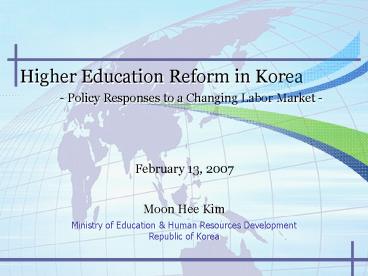Higher Education Reform in Korea - PowerPoint PPT Presentation
1 / 20
Title:
Higher Education Reform in Korea
Description:
Title: 1 Author: XPuser Last modified by: men Created Date: 3/30/2006 5:59:32 AM Document presentation format: Affichage l' cran Company – PowerPoint PPT presentation
Number of Views:86
Avg rating:3.0/5.0
Title: Higher Education Reform in Korea
1
Higher Education Reform in Korea - Policy
Responses to a Changing Labor Market -
February 13, 2007
Moon Hee Kim Ministry of Education Human
Resources Development Republic of Korea
2
CONTENTS
1
Overview
2
The Change of Labor Market
3
HE Policy Responses to Labor Market Change
3
1.
4
Number of Students Schools, HE
ltAs of April 1, 2006gt
5
Economic Development
1970 1980 1990 1997 1998 2000 2004 2005
Population (Millions) 32 38 43 46 46 47 48 48
GNI per capita (US) 650 2,324 7,751 10,363 6,843 9,675 14,193 16,291
Unemployment rate () 4.4 5.2 2.4 2.6 6.8 4.1 3.7 3.7
Labor force (Millions) 10 14 19 21 21 22 23 24
Labor force Participation rate () 47.6 59.0 60.0 62.2 60.5 60.7 62.1 62.0
6
Sequential Expansion of Education
- Step-by-step attainment of universal education
primary ? secondary ? higher education
Elite
Mass
Universal
? Trow, Forms and Phases of Higher Education
Elite ? Mass ? Universal
7
Policy Foci for Economy and Education
Economy Period Education
Take-off export-driven growth(60s) export acceleration(early 70s) 1960s mid-1970s Expansion of primary and middle school education emphasis on TVET(late 60s)
Structural adjustment(late 70s) from imitation to innovation(80s) mid-1970s 1980s Expansion of high school and higher education strengthening of TVET
Pursuit of national competitiveness(early90s) knowledge-based economy(late 90s) 1990s Present K-12 quality enhancement investment in higher education reform for lifelong learning
8
2.
The Change of Labor Market
9
Changes in Industrial Structure
lt Employment Structure gt
? 2015p Agriculture 5.5, Manufacturing
Construction 18.3, Service 76.2
10
Demographic change
Low Fertility
Ageing
Demographic structure age group
Total fertility rate No. of birth
11
Youth Unemployment
- Youth(1529?) Unemployment(06.11),
7.5(34.3mil.) 2.3times greater than the overall
UR
Unemployment rate()
12
Skill Mismatch / Low Satisfaction
- Skill Mismatch in labor force
Supply
Lack of qualified core talents
Demand
Youth unemployment (343,000)
Labor shortage at SMEs (197,000)
- Low level of satisfaction towards university
graduates
? Ranked 50th out of 61 countries in terms of
university education meeting economic
demands(IMD, 2006)
13
Wage gaps / Wage premium
- Increasing non-regular employment ? widening a
wage gap. - University premium decreased until mid-90s but
14
3.
HE Policy Responses to Labor Market Change
15
Vision and Goals
Globally Competetive Higher Education
Industrial engineers (Junior Colleges )
Restructuring competition
Selected funding for specialization
LB information
Partnerships
16
Major strategies
- Improvement of HE/labor market information
- - manpower forecasting and assessment of
skill requirements - Promotion of restructuring and competition
through - market discipline
- - use of various incentives and disincentives
- Funding based on selection and concentration
- - targeted funding for specialization and
regional parity - Financing learners rather than providers
- - learner-oriented/demand-side financing
(student loans) - Enhancement of networking and partnerships
- - with local governments and business community
17
HE Reform Initiatives
- Strengthening graduate programs in high
value-added service areas medicine, law,
international finance, MBA, etc - Introduction of a new HE quality assurance system
- - Establishing the new quality assurance
agency including the - accreditation and certification process
with global standard - - Financial provisions aligned with
institutional evaluations - Clearing HE information
- - Inputs measures PT ratio, unit
expenditure, occupancy/ enrollment rate - - Process/Outcome measures
persistence/graduation rate, employment - rate, customer satisfaction, etc.
- Financial incentives for reform and restructuring
HE Inst. - - Subsidies linked to amalgamation among
institutions
? Reducing enrollment by 50K students by 2009(18
inst. merged into 9, as of 2006)
18
Major Programs to enhance the Quality
(1US 1,000KRW)
? 1st-Phase Brain Korea 21 (19992005, US
1.4billion) ?Enhanced university research
capacity induced competition ? Number of
BK21 science tech SCI-level papers 3,765(1998)
? 7,947(2005) ?Produced scientists of
international competence ? Number of
doctors in science tech(19992005) 6,602 ?
2nd-Phase Brain Korea 21 (20062012, US
2.3billion) ?Cultivate 20,000
graduate-level best brains per year ? 74
universities, 244 project units, 325 project
teams(2006, US 290million) ? New University for
Regional Innovation (20042008, US 1.2billion)
?Specialize local universities nurture human
resources readily adaptable to the
industry ? 109 local universities, 130
project units ? Connect Korea
Project(20062010, 150million)
?Strengthening partnership b/w universities and
industry ?Establishing Consortium b/w TLOs
(Technology Licensing Offices) in univ.
19
Government Role
Before Now
Name MOE MOEHRD
Head Minister Deputy Prime Minister(DPM)
Scope Education, Adult Education Education, LLL, Coordinating HRD Policy
- Coordinate HRD/VET polices among different line
ministries. - - Ministerial Committee on HRD (chairperson
DPM) - - The Committee is composed of 14 Ministers
20
Thank you
mhk3333kim_at_moe.go.kr































